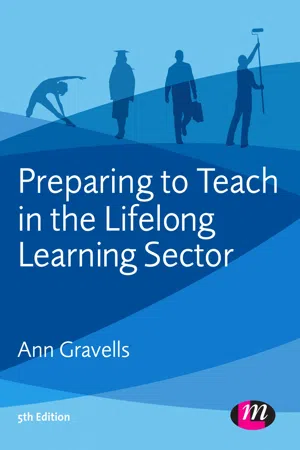
- 176 pages
- English
- ePUB (mobile friendly)
- Available on iOS & Android
eBook - ePub
About this book
This book is a guide to the PTLLS Award (which has been replaced with the Award in Education and Training) and is a comprehensive introduction to teaching in a variety of settings. This includes further education, adult and community learning, work-based learning, the forces and offender learning and skills. It is easy to read with plenty of practical activities and examples throughout and the content is fully linked to the Teacher Training Standards.
Please note: This book has since been updated to reflect the new title of the qualification: The Award in Education and Training.The qualification unit content contained in the appendices has since changed, and some legislation mentioned in the book has been updated.
Please note: This book has since been updated to reflect the new title of the qualification: The Award in Education and Training.The qualification unit content contained in the appendices has since changed, and some legislation mentioned in the book has been updated.
Frequently asked questions
Yes, you can cancel anytime from the Subscription tab in your account settings on the Perlego website. Your subscription will stay active until the end of your current billing period. Learn how to cancel your subscription.
No, books cannot be downloaded as external files, such as PDFs, for use outside of Perlego. However, you can download books within the Perlego app for offline reading on mobile or tablet. Learn more here.
Perlego offers two plans: Essential and Complete
- Essential is ideal for learners and professionals who enjoy exploring a wide range of subjects. Access the Essential Library with 800,000+ trusted titles and best-sellers across business, personal growth, and the humanities. Includes unlimited reading time and Standard Read Aloud voice.
- Complete: Perfect for advanced learners and researchers needing full, unrestricted access. Unlock 1.4M+ books across hundreds of subjects, including academic and specialized titles. The Complete Plan also includes advanced features like Premium Read Aloud and Research Assistant.
We are an online textbook subscription service, where you can get access to an entire online library for less than the price of a single book per month. With over 1 million books across 1000+ topics, we’ve got you covered! Learn more here.
Look out for the read-aloud symbol on your next book to see if you can listen to it. The read-aloud tool reads text aloud for you, highlighting the text as it is being read. You can pause it, speed it up and slow it down. Learn more here.
Yes! You can use the Perlego app on both iOS or Android devices to read anytime, anywhere — even offline. Perfect for commutes or when you’re on the go.
Please note we cannot support devices running on iOS 13 and Android 7 or earlier. Learn more about using the app.
Please note we cannot support devices running on iOS 13 and Android 7 or earlier. Learn more about using the app.
Yes, you can access Preparing to Teach in the Lifelong Learning Sector by Ann Gravells in PDF and/or ePUB format, as well as other popular books in Education & Adult Education. We have over one million books available in our catalogue for you to explore.
Information
1 TEACHING AND LEARNING
Introduction
In this chapter you will learn about:
- roles and responsibilities of a teacher
- boundaries of teaching
- record keeping
- legislation and codes of practice
There are activities and examples to help you reflect on the above which will assist your understanding of the process of teaching and learning. At the end of each section there are extension activities to stretch and challenge your learning further.
At the end of the chapter is across-referencing grid showing how the chapter’s contents contribute towards the professional teaching standards and PTLLS units.
Roles and responsibilities of a teacher
Most careers are quite challenging and demanding, and teaching is no exception to this. However, it can be very rewarding when you see your students’ achievements and success, which is a direct result of your contribution. Your main role as a teacher should be to teach your subject in a way that actively involves and engages your students during every session. However, it’s not just about teaching, it’s also about the learning that takes place as a result. You should use clear language at an appropriate level and in terms your students will understand, motivating them to want to learn more. You should also manage the learning process from when your students commence to when they complete, ensuring you assess their progress, give relevant feedback and keep appropriate records.
How you do this will depend upon your subject, the age and experience of your students and the environment you will teach in. Becoming a good teacher includes being enthusiastic and passionate about your subject, being approachable and taking pride in your work, which will all be conveyed to your students through your teaching approaches.
Example
Zak always arrives early to his sessions, he ensures the room is tidy and organises the tables and chairs in a way that encourages communication. He creates an approachable environment and delivers his subject with passion and enthusiasm. He uses lots of examples and anecdotes to relate his subject to real life. He includes all his learners by addressing them personally, yet remains fair with the support and advice he gives. He always tidies up afterwards and e-mails additional learning materials as required. His learners see how conscientious and professional Zak is and begin to emulate this by being early, being polite and submitting work on time.
A good first impression will help establish a positive working relationship with your students. The way you dress, act, respond to questions, offer support, etc., will also influence your students. They don’t need to know anything personal about you, but they will probably make assumptions about you. If asked personal questions, try not to give out any information: by remaining a professional, and not becoming too friendly, you will retain their respect. Most teachers are on first name terms with their students. However, you will need to decide what is appropriate to your situation. Establishing routines will help your sessions flow smoothly; for example, always starting on time, setting and keeping to time limits for activities and breaks, and finishing on time.
Activity
How could you create a good first impression with your students? What would influence this, for example your own previous experiences of attending a session?
The teaching and learning cycle
The teaching and learning cycle is so called as it can start at any stage and keep on going. However, all stages must be addressed for teaching and learning to be effective. The chapters in this book are based on the cycle, which consists of the stages outlined in Figure 1.1 below.
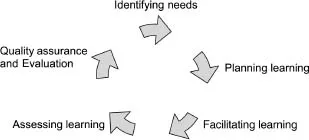
Figure 1-1 The teaching and learning cycle
Your role w ill usually follow the cycle and briefly involve:
- identifying needs – finding out what your organisation’s, your own, and potential students’ needs are, carrying out initial assessments, agreeing individual learning plans
- planning learning – preparing a scheme of work, session plans and teaching and learning materials to ensure you cover the requirements of the syllabus, liaising with others
- facilitating learning – teaching and facilitating learning using a variety of approaches
- assessing learning – checking your students have gained the necessary skills and knowledge
- quality assurance and evaluation – obtaining feedback from others, evaluating yourself and the programme in order to make improvements for the future. Evaluation should also be an ongoing process throughout all stages of the cycle.
Most teachers follow the cycle from beginning to end; however, your job role might not require you to be involved with all aspects. You will probably undertake a variety of roles during your teaching career, each having various responsibilities or duties that you must carry out. The job roles do not relate to whether you are employed full-time or part-time, but to the duties you will perform. There are two teaching roles in the further education sector in England:
- Associate teaching role which has fewer teaching responsibilities and will be performed by those who are expected to gain the status of Associate Teacher, Learning and Skills (ATLS). An Associate Teacher will usually teach using materials prepared by others.
- Full teaching role which represents the full range of responsibilities performed by those who are expected to gain the status of Qualified Teacher, Learning and Skills (QTLS). A Full Teacher will perform all aspects of the teaching and learning cycle.
Table 1.1 on page 12 lists examples of teaching roles and responsibilities, based on the teaching and learning cycle. Don’t be concerned by the amount of detail in the table; your job role might not require you to carry them all out. If there is anything you are unsure of at the moment, as you progress through the book it should all become clear.
To teach effectively involves not only the approaches you use to teach your subject, but many other factors that go before and after the taught session. This includes planning your sessions, preparing your teaching materials, assessing your students, marking work, giving feedback and evaluating yourself and the experience your students have. Never underestimate the amount of time you will need to dedicate to the role.
Table 1.1 Examples of teaching roles and responsibilities
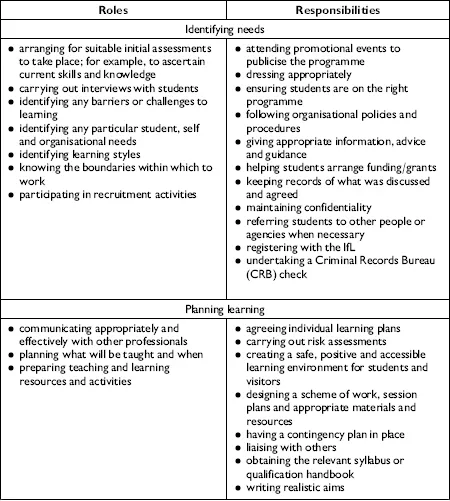
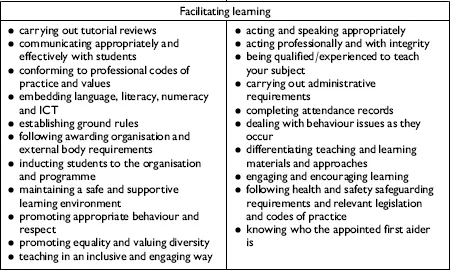

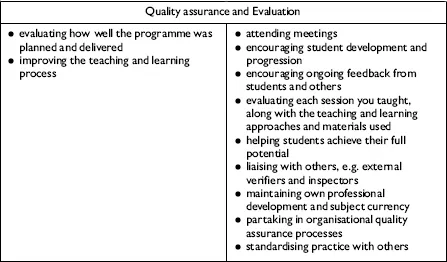
Your personality and mannerisms will be noticed by your students. You may do things you are not aware of; for example, waving your arms around or fidgeting. It is really useful to make a visual recording of one of your sessions to enable you to watch yourself afterwards. You may see things you didn’t realise you did or things that you would like to change. Smiling when you meet your students will help you and them relax.
If you are new to teaching, you may find you are teaching in the same way you were taught at school or college. This could be lecturing, reading from a book or writing information on a board, which might not have been very effective for you. You won’t yet know all the other methods you could use to make learning interesting and engaging. Active learning helps people remember; passive learning may lead them to forget. As you become more experienced at teaching, your confidence will grow and you will be able to experiment with different approaches, as not all teaching methods suit all students.
Extension Activity
Think about the subject you would like to teach, the age group of your students and the environment in which you will teach. What do you consider your roles and responsibilities will be to ensure learning is effective? If you are currently teaching, compare your responses with your job description.
Boundaries of teaching
You will have professional boundaries within which to work and it’s important not to overstep these by becoming too personal with your students. Boundaries are about knowing where your role as a teacher stops and working within the limits of that role. Table 1.2 on page 15 lists some of the boundaries you may encounter in relation to the teaching and learning cycle.
Example
Navinda had been teaching a group of 16 students once a week for six weeks. She occasionally e-mailed them between sessions to inform them of room changes. Two of her students sent her an e-mail inviting her to join their social networking site. She politely refused, to ensure that she remained professional in her role as their teacher.
Table 1.2 Boundaries of teaching
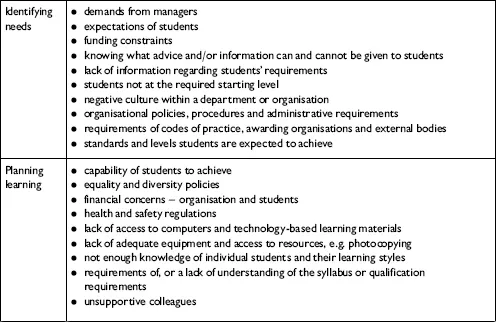

You need to remain in control, be fair and ethical with all your students and not demonstrate any favouritism towards particular students; for example, by giving one more support than the others. You might feel it sensible to make a telephone call to a student who has been absent but making regular calls would be inappropriate. Giving your personal telephone number to students could be seen as encouraging informal contact, and you may get calls or texts which are not suitable or relevant. You might not want to take your break with your students or join their social networking sites as you could become more of a friend than a teacher. It is unprofessional to use bad language, to touch students in an inappropriate way or to let your personal problems affect your work. Boundaries also include the constraints you might be under as a teacher; for example, the amount of paperwork you are expected to complete or the lack of fun...
Table of contents
- Cover Page
- Title Page
- Copyright
- Contents
- Acknowledgements
- Author Statement
- Introduction
- 1 Teaching and learning
- 2 Theories of learning
- 3 Identifying needs
- 4 Planning learning
- 5 Facilitating learning
- 6 Assessing learning
- 7 Quality assurance and evaluation
- 8 Micro-teaching
- Appendices
- Index